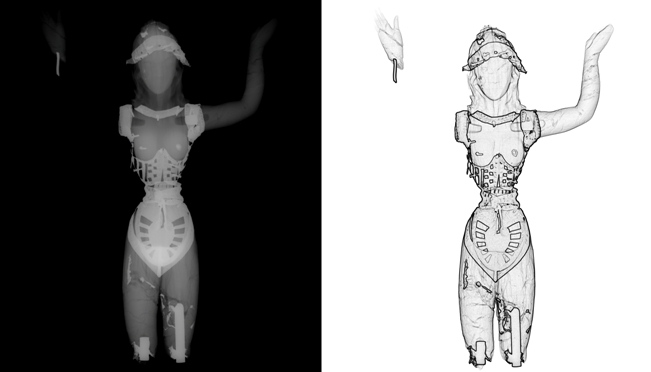Exposing the ROM ‘Minoan’ Goddess

An X-ray and graphic rendering of the ‘Minoan’ Ivory Goddess
© ROM
Here I continue the story of an icon of the Royal Ontario Museum (ROM) collection: the ivory and gold female figurine–ROM 931.21.1. For further information see the ‘Minoan’ Ivory Goddess Research Project.
I’m very excited to announce that a short video about goddess has just gone live!
The Minoan Goddess Exposed gives everyone a close look at the controversial ivory figurine, focusing on her surface appearance and what is going on underneath her clothes.
You might notice from what we are wearing that the filming was actually done back in the summer. A lot of time and hard work has gone into turning a 45-minute conversation on camera into the 10-minute finished product. Here are a few photographs taking you behind the scenes while we made the video and showing you the people involved, and I am very grateful to all of them for their help.
 Julia Fenn and Kate being filmed by Zak Rogers in the ROM Conservation department
Julia Fenn and Kate being filmed by Zak Rogers in the ROM Conservation department
Photo: Scott Loane
 In the X-ray studio in the ROM Conservation department with Heidi Sobol & Julia Fenn
In the X-ray studio in the ROM Conservation department with Heidi Sobol & Julia Fenn
Photo: Kate Cooper
 The ROM Sound Studio where Scott Loane & Zak Rogers work their magic in editing the film
The ROM Sound Studio where Scott Loane & Zak Rogers work their magic in editing the film
Photo: Kate Cooper
What have we learnt?
As well as being a great way to let you see the figurine face-to-face, the surface and x-ray analysis shown on the video has helped us answered some fairly basic questions about the figurine. Here is a summary what we have discovered as a result of the visual analysis.
- First of all, our close examination of the details of the carving has emphasised that the figurine is an exceptionally skillful piece of ivory-work, whenever it was made.
- We’ve established that the figure is elephant ivory, and not hippopotamus or even mammoth ivory. Many Minoan Bronze Age figurines were made of hippopotamus ivory, although elephant ivory was also used.
- By taking off some of the clothes, and x-raying the object, we’ve seen for the first time that the torso of the figure is certainly carved from a single piece (although the two arms are detachable). Stylistically this doesn’t help to date the piece, since the Minoan ivory figurines found in controlled excavations are sometimes carved as a whole, and sometimes carved in pieces, but the pattern of cracks in the ivory show that this was carved from an unusually straight elephant tusk. This could help to identify the species of elephant, which could in turn help with dating the figurine.
- The pattern of carving underneath the gold clothing is not consistent in different places on the figurine. While underneath the belt there is carving in the ivory which echoes the pattern of the belt itself, the ivory underneath the gold bodice and codpiece has no carving. This may suggest that the bodice and codpiece were later additions, not part of the original figurine. The same may be true of the diadem now worn by the figurine. This doesn’t seem to fit the carving that appears on the hair on the back of the head, suggesting that the figurine originally wore a different type of headband.
These may seem straightforward points, but they haven’t ever been confirmed before.
Photos by Kate Cooper & Scott Loane

